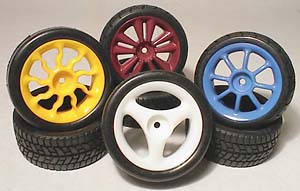All RPM nylon parts can be dyed with outstanding results! This includes parts that are natural white, yellow, blue, etc. The key to remember is that you can only dye a part darker than its current color. For example, a yellow part can be dyed orange, red, green ,blue, purple, etc. Yet a blue part can only be dyed a darker shade of blue, dark purple or black.
To get started, simply boil some water, add some fabric dye (we prefer Rit™ clothing dye) of the color you want to the boiling water. Start with a small amount of dye and add more later if the parts don’t reach the desired color depth. Don’t forget to remove the parts from the solution before adding more dye! Place your new RPM dyeable parts in the water, leaving nothing exposed. Be sure that the dye is completely saturated in the water before adding your parts! The depth and shade of the color will vary depending on time they are left in the solution, the amount of dye used, and the temperature of the water. Usually, higher concentrations of dye darken the color of the parts faster, as will higher water temperatures. Use caution because your parts will look lighter in color when first removed from the hot water. When the color looks close, but still slightly lighter than what you want, remove the parts from the water/dye solution and let them cool. They will darken slightly after cooling. If they aren’t quite dark enough at this point, place them back in the solution for a brief time until the color is to the tint of your choice.
Important note: To make all of your parts identical in color, either dye all of them at the same time, or take careful notes during the dyeing process such as;
1) Water temperature (i.e. fast boil, slow simmer, etc.).
2) Amount of dye and water used.
3) Type and manufacturer of the dye.
4) Time the parts spent in the dye solution.
Additional Note: Because this is a dyeing process of the parts, and not a plating process, the dye will have absolutely no effect on adhesive bonds when tires are glued to our dyeable wheels.

